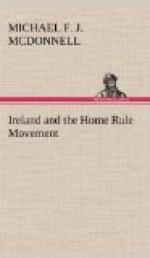tend to become the most moderate with advancing years—a
fact of which a classic example is to be found in
the career of Sir Charles Gavan Duffy, one of the
most distinguished of the Young Irelanders, who, after
a brilliant career in Australia, returned to European
his old age and spent several years in the attempt
to persuade Conservatives to adopt the policy of Home
Rule—a propaganda on his part to which the
episode of Lord Carnarvon bears witness, and which
was advocated by him in the National and Contemporary
Reviews in 1884 and 1885. It may well be
that the political groundlings who are at present the
backbone of the Sinn Fein movement will, when they
gain political experience, alter their views in as
complete a manner. One can draw an English parallel
to this movement in Ireland. There are in the
former, as in the latter, country a certain limited
number of people who hold extreme political views,
which in the case of the English are pure socialism.
The English extremists have been so far successful
as to secure the return of one Member of Parliament
in full sympathy with their aspirations. The Irish
extremists have not so far dared to put to the test
their chance of obtaining even one Parliamentary ewe
lamb. Without the advantage which the English
intransigeants possess, of a few weeks’
knowledge on the part of one person of the inside
working of Parliamentary government, in exactly the
same manner as do the Englishmen of the same type,
these Irishmen spend their time reviling popular representatives
as ignorant, venal, and beneath contempt. A prophet
who, on the basis of the election of Mr. Grayson,
foretold an imminent dissolution of the democratic
forces in Great Britain, would in truth have more ground
on which to base his forecast than has one who from
the nebulous movements of the Sinn Fein party, arrives
at an analogous conclusion in the case of Ireland.
That the political landmarks in Ireland have in the
last few years shifted is obvious to the most superficial
observer. The devolutionist secession from orthodox
Unionism, the Independent Orange Lodge represented
by Mr. Sloan, the “Russellite” Ulster tenant-farmers,
and the rise of a democratic vote in Belfast regardless
of the strife of sects, all serve as indications of
this fact; but let it be noted that while we have
evidences in these directions of the forces at work
in the disintegration of the old Orange strongholds,
we have no such obvious indications of the upheaval
going on in the traditional Nationalist Party, save
only the mere ipse dixit of the very people
who assure us that they themselves are making it felt.
There is every reason to suppose that the Sinn Fein
movement, in so far as it consists of passive resistance,
will be regarded by the Irish people as merely doing
nothing. They could understand a non-Parliamentary
action were it replaced by physical force, and the
weakness of passive resistance lies precisely in this,
that the logical result of its failure is an appeal




